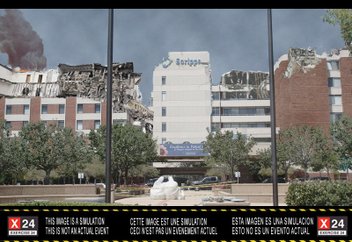The image shown here is an illustration of a partial collapse of Scripps Hospital in La Jolla following a hypothetical earthquake, part of a two-day earthquake drill in California organized by San Diego State University. The drill, named Exercise 24 or X24, was conducted to explore the effectiveness of social media in disseminating news following a catastrophe. Twitter was widely used following this year’s earthquake in Haiti and floods in Pakistan. Eric Frost, director of SDSU’s Immersive Visualization Center or VizLab, which produced the image of the collapsed hospital, noted the value of citizen journalists in the aftermath of a disaster. “You get a lot of citizens who become your eyes on an event,” he said. “You get people reporting on not only things like a fire but a traffic accident or whether Mrs. Smith is still at the convalescent home. People come to take care of their own community rather than expecting government to do all of it.” The drill began when a test message published on Twitter reported a 9.2 magnitude earthquake in southern California, followed by additional test messages on the consequences of the disaster, such as a commuter rail accident. The participants in the drill directed the public to www.inrelief.org, a U.S. Navy site that shares disaster relief information. The goal of the drill was to see the participants, emergency responders and relief agencies as diverse as the American Red Cross and the California Department of Public Health, share information. I was fascinated to read of this drill as we had reported in the first edition of our book how the news media frequently misreported events in the aftermath of 9-11. Everyday tasks such as the commute to work became a struggle as information on changing commuter paths were difficult for larger organizations to keep up with. Instead, neighbors relied on one another, including our infamous lobby bulletin board, to stay informed. But that was before Facebook, Twitter and other social media platforms took off.
